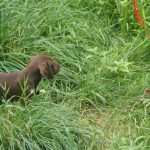Pointing Dog Pointer: More is Not Better
By Bob and Jody Iler
In our “super-size it” society of today, more is often considered better. More money, more possessions, more leisure time. And though it’s great to have extra cash, lots of toys, and plenty of free time to enjoy them—sometimes more really isn’t better. Especially when it comes to training your pointing dog!
It’s true that from the time you bring your new puppy home, you are training her. You work on housebreaking and basic puppy commands, and strive to establish that critical bond with her through your voice, your touch, and with physical gestures.
But during the process of developing her as a bird dog and maintaining that training in the early seasons of hunting, it’s crucial to remember one important thing: more is not always better! We’ve put together a list of the potential pitfalls to avoid. As you read through and consider them, you may even think of a few of your own!
Training in Cover That is Too Dense and High
The temptation is great, once the game preserves close and hunting season is months away, to think that we really need to be working our dogs on birds. But much of the habitat in summer is just not conducive to successful training sessions. If you can’t see your dog in thick dense cover, you can’t keep him out of trouble. Poor flying birds will have difficulty flushing out of the cover quickly and may be caught by the dog. Repeating this scenario often can result in softening or eliminating a young dog’s point.
Training in Excesses of Weather
Your dog can’t often be successful when you get him out in weather that’s too dry, too wet, or too hot. Scenting conditions will not be the best and though he may try hard to find birds, the cards won’t be stacked in his favor. If the young dog is trying hard and worked in difficult scenting conditions, he may lose interest in the whole business, become distracted, and quit hunting. As for too hot of weather, if you work up a sweat while walking, it’s much too hot to train your dog. A dog with enthusiasm and drive will overheat quickly and working him in hot weather is extremely dangerous.
Too Much Voice, Too Much Handling
This is a common mistake that overeager novice trainers make. The more you yell, whistle and over handle a dog, the less she will listen to you. She must first learn what you want through patient, quiet repetition. Use your voice sparingly and quickly enforce your commands rather than repeating them loudly or over-using your checkcord. Particularly when a dog is on point, yelling “whoa” and snapping the line can distract her and even cause flagging. And one more reminder: the pointing dog needs to get out and cover the ground for you. Constantly hacking her in with your voice and checkcord defeats the purpose of having one!
Too Much Retrieving
Young dogs are especially prone to problems if retrieving is overdone. One or two successful retrieves in a session is plenty. This keeps the enthusiasm and freshness uppermost with each retrieve. The temptation is great to capitalize on a couple good retrieves. If one or even two retrieves are great—won’t more be better? Too many retrieves at one time often causes the young dog to lose interest and want to simply continue hunting instead. Some dogs are natural at this game and never seem to tire of retrieving, but it’s usually better to stay with a short, positive program that fosters continued retrieves rather than gamble.
Too Many Guns
Of all the areas where less is better than more, this one should be highlighted and read and repeated often. Too much shooting over a dog can cause gun shyness at worst and gun nervousness at best. The dog should be slowly developed to progressive levels of noise while focused on the birds, often chasing them after the flush. At no time should the dog ever indicate, in this scenario, that he is aware of the noise of the gun. These things apply to the seasoned dog as well. Shooting an automatic several times at one bird, having two hunters shoot over one dog at the same time, or shooting a bird that your pup is not working, can all cause problems. Curing the gun shy dog is much harder than preventing one from becoming gun shy!
Too Many Hunters
In this scenario you are combining many “More is Not Better” elements: too many hunters with too many guns and too much shooting—a recipe for disaster. In addition, too many hunters giving too many commands to a dog is confusing and can undo much of your training. Especially in the early seasons of your pup’s experiences, stick with one hunter/handler, one gun, and one dog. Give her a chance to learn to work with you, bond with you, and figure out what it’s all about.
Training Sessions: Too Many and Too Long
We all love our pointing dogs and want to spend time training them. That’s a good thing! But when was the last time you were able to sit through a long-winded speech or presentation without your mind wandering? If you are asked to repeatedly redo a job or project without a break, do you get better at it or worse? In developing your pointing dog, consistent, short lessons that end on a positive happy note are the most successful. Grueling, hour-long daily sessions are way too much for a pup. Working the dog until he “gets it right” can often do more harm than good. Keep it simple, fun, consistent and short and you’ll move ahead at your pup’s natural pace, bringing out her natural abilities as she matures.
Too Much Training Equipment
It’s a lot of fun to get out the latest dog supply magazine or check them out online for all the new training gadgets and equipment. Many of them are great and work well. But to train and develop your pointing dog pup, all you really need is a good 20 ft. checkcord, slip collar and lead, a good whistle, and access to plenty of birds and nice grounds to train on. The one thing you shouldn’t skimp on is knowledge: read everything you can find about training and developing pointing dogs. Talk to people who have good dogs. Visit field events. Learn and sift the information. Take what you think fits you and your pup. Add patience, time and dedication and you can’t lose!
Pointing Dog Pointers features monthly training tips by Bob and Jody Iler, who own Green Valley Kennels in Dubuque, Iowa. Bob and Jody have trained pointing dogs for over 35 years and have written many articles for The Pointing Dog Journal.





